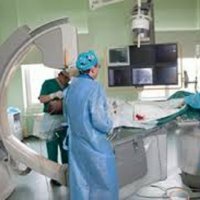Coronary artery stenting

One of the most important achievements in cardiology belongs to the stenting of the coronary arteries. In 1968, the first stent installation in the artery was performed. In our time, this procedure of the coronary arteries is almost outpatient. It is also called "surgery of one day".
What happens during stenting of the coronary arteries?
In coronary stenting, using a catheter in the artery of the heart, a thin metal tube is called, called a stent. It helps prevent the narrowing of the arteries, and accordingly the development of myocardial infarction. A stent is established only after the artery has been dilated by means of angioplasty.
There are two types of stents. These are drug-coated stents. When the stent is covered with a drug that is gradually released. It reduces the likelihood of re-narrowing of the coronary arteries. The second type of stent does not have a drug coating. The choice of the type of stenting, which is most suitable for the patient, remains with the attending physician.
What is the goal of stenting of these arteries?
This procedure is done to provide a normal blood flow through a previously blocked artery in the heart. After the end of stenting, the lumen of the artery remains open. This will ensure normal blood flow in the heart muscle. It also improves the quality of life - pains in the chest, the patient feels better.
Possible complications of this procedure
Before conducting coronary artery stenting, a specialist should consider all possible complications of this procedure. This is the development of myocardial infarction or heart rhythm disturbances, an allergic reaction to the drug, bleeding at the site of the catheter, the development of a stroke. Also, it is necessary to take into account the technical possible difficulties, up to the impossibility of installing the stent.
Factors that increase the risk of complications include obesity, blood clotting disorder, allergy to medicines, smoking, old age. Also kidney disease, diabetes, recent pneumonia.
Preparing for stenting the coronary arteries and describing the procedure
Before this procedure, it is necessary to pass blood tests( biochemical and general), an electrocardiogram is needed. Also, a chest X-ray is performed. Anesthesia( local) in the groin area is performed before the stenting procedure.
The groin area where the arterial catheter is installed, shaved, treated with an antiseptic. An introducer or a thick needle is inserted into the artery. In the arterial channel, a catheter moves along the conductor until it reaches the blocked artery in the heart. The x-ray surgeon performs X-rays during the procedure to find out where the conductor is, also a catheter. An x-ray contrast preparation is injected into the arteries of the heart. This enables the specialist to examine the arteries, and also to identify the sites of their narrowing.
When a critical arterial constriction site is identified, a conductor is placed behind the constriction site. It provides accurate placement in the artery of the catheter. A miniature balloon is blown quickly at the end of the catheter with air and then deflated again. This allows you to open the artery. The air reservoir is refilled to install the stent to expand the stent to its full size. The stent remains in place, after which it can be considered open the vessel walls. The conductor and catheter with cans are removed. Pressing the place of catheterization prevents possible bleeding. In the groin area medics impose a sterile bandage.
After the procedure, the patient is motionless for a certain time in the intensive care unit, under the strict supervision of the doctor. In the area where the catheter was installed, there continues to be a special pressing bandage to prevent bleeding. The duration of stenting of the coronary arteries can be from 30 minutes to 3 hours, depending on the characteristics of the disease. The patient stays in the hospital for about 2 days.
Stenting of these arteries is one of the most effective ways to treat unstable angina. This method of treatment can become life-saving in the first day of myocardial infarction( acute).After the procedure, if you have complications, you should immediately call your doctor.

